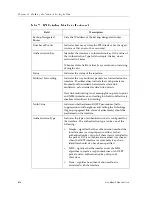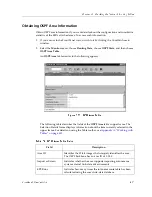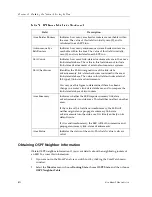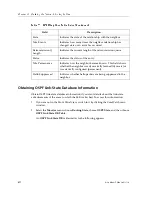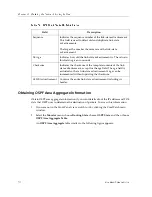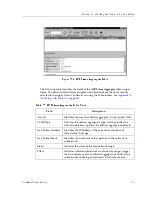
Chapter 18: Checking the Status of Routing Tables
308
CoreWatch Users Guide
the upper frame. For details on using the Table toolbar, see
Appendix A:
“Working
with Tables” on page 331
.
Table 59. DVMRP Neighbor Table Fields
Field
Description
Index
Identifies the value of the virtual interface index used to reach
the neighbor.
Address
Identifies the IP address of the neighbor.
Up Time
Indicates how long ago the DVMRP neighbor last became a
neighbor to the SSR.
Expiry Time
Indicates the minimum amount of time remaining before the
neighbor's entry will be deleted from the DVMRP Neighbor
table.
Generation ID
Identifies the neighboring router's generation identifier.
Major Version
Indicates the neighboring router's major DVMRP version
number. The SSR's major version number is 3.
Minor Version
Indicates the neighboring router's minor DVMRP version
number. The SSR's minor version number is 255.
Capabilities
Describes the neighboring router's capabilities. These
capabilities are:
•
Leaf – signifies that the router has only one interface with
neighbors.
•
Prune – signifies that the router supports pruning.
•
GenerationID – signifies that the neighbor recognizes
generation identifiers and sends that information in Probe
messages.
•
mtrace – signifies that the neighbor can handle mtrace
requests. The mtrace command tracks the multicast path
from a source to a receiver.
Rx Routes
Indicates how many routes the SSR received in valid DVMRP
packets received from the neighbor.
This figure is useful in diagnosing problems as well as
indicating the level of DVMRP traffic.
Rx Bad Packets
Indicates how many invalid packets the SSR received from the
neighbor.
Rx Bad Routes
Indicates how many of the neighbor's routes the SSR ignored.
The SSR ignores invalid route entries.
Summary of Contents for SSR-ATM29-02
Page 1: ...CoreWatch User s Guide 9032564...
Page 2: ......
Page 6: ...Notice vi...
Page 14: ...Contents 14 CoreWatch User s Guide...
Page 18: ...Preface 18 CoreWatch User s Guide...
Page 134: ...Chapter 9 Configuring Unicast Routing on the SSR 134 CoreWatch User s Guide...
Page 194: ...Chapter 12 Configuring QoS on the SSR 194 CoreWatch User s Guide...
Page 234: ...Chapter 13 Configuring Security on the SSR 234 CoreWatch User s Guide...
Page 258: ...Chapter 15 Checking System Status 258 CoreWatch User s Guide...
Page 278: ...Chapter 16 Monitoring Real Time Performance 278 CoreWatch User s Guide...
Page 316: ...Chapter 18 Checking the Status of Routing Tables 316 CoreWatch User s Guide...
Page 326: ...Chapter 20 Monitoring Faults 326 CoreWatch User s Guide...
Page 330: ...Chapter 21 Obtaining Reports 330 CoreWatch User s Guide...
Page 344: ...Appendix B CoreWatch Menus 344 CoreWatch User s Guide...

